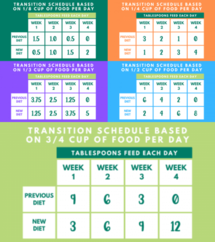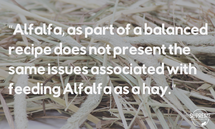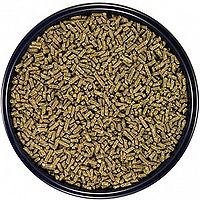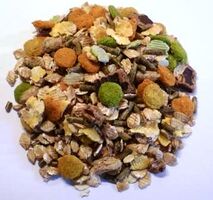Pellets
Pellets provide rabbits with an easy source of essential nutrients. Some rabbit owners choose to feed their rabbits a pellet-free diet due to teeth problems, chronic GI issues, and obesity. However, a pellet-free diet requires much more effort and care as a rabbit can easily suffer from malnutrition without the provision of proper vitamins and minerals.
What amount of pellets should I feed my rabbit?
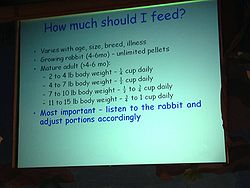
For an adult rabbit over 6-7 months of age, we recommend that you feed 'at most' 1/8 cup to 1/4 cup of pellets per rabbit per day for every 5 lbs of rabbit. Too many pellets may lead to obesity, a lack of teeth wear, cecal overproduction, poopy butt, and behavioral disorders.[1]
However, baby rabbits under the age of 6-7 months can be fed unlimited young rabbit pellets, as their bones and muscles need plenty of protein and calcium for proper growth.[2] For babies, an auto feeder may be appropriate so that you will not need to check on the bowl constantly to top it off.
Please note that you can feed even less pellets than recommended for a healthy rabbit. The proper balance of hay, vegetables, pellets, and fruit may be different for each rabbit in your home and may change for an individual rabbit as they grow older or as their health changes.
How should I change pellets for my rabbit?
Due to their sensitive digestion, it is a good idea to slowly transition pellets each time you change to a new brand for your rabbit. Some rabbits may end up with soft poops or even stasis if new foods are introduced too much too quickly. A good rule of thumb is to introduce new pellets at about 25% increase per week. If you do not have any more old pellets on hand to transition with, start with a single tablespoon or pinch of pellets for a week, and slowly increase the daily pellet amount per week as the rabbit shows no sign of stomach upset.
The following resources have some more details about transitioning food for rabbits:
- Oxbow. (2020). How to Transition Your Pet’s Food
What different types of pellets are there?
The type of pellet (alfalfa or timothy) fed usually depends on the age of your rabbit. Generally, alfalfa-based pellets should be fed to rabbits under 7 months old and timothy-based pellets to rabbits over 7 months old. However, it ultimately depends on the nutrition values listed on the back of the bag. Both types of pellets can meet nutritional requirements for rabbits.[3] Typically, commercial alfalfa-based brand pellets will have more calories, protein, and fat, and less fiber than a timothy-based brand. See Rabbit Pellets Comparison Chart for more information about some acceptable brands for both adult and young rabbits.
Rabbit pellets can also come in two different types based on manufacturing method: compressed and extruded. Compressed pellets like Oxbow Essentials and Sherwood Forest are made into a small pellet form with compression at low temperatures. Pellet binders are often used to improve the cohesion of the pellet.[4]
Extruded pellets like Supreme Science Selective, also called nuggets, are first ground and mixed, then pasteurized at a high temperature, which breaks down the starch and protein bonds. Afterwards, the mixture is pushed through a die, and the sudden drop in temperature after the feed emerges from the die into the cooler air causes the starch molecules to explode into low-density lightweight pellet.[5] The extrusion process makes starches and other nutrients easier to digest, and fiber length can be greater in an extruded pellet compared to a compressed pellet.[6]
For pellets, especially the smaller compressed pellets, please be mindful of possible choking hazards. Some rabbits can choke when they eat pellets too fast without chewing, especially if they have pre-existing dental issues. Consider feeding them scattered on the ground or mixed in hay or other puzzle and foraging toys to prevent choking incidents.
Why shouldn't I feed my rabbit a muesli mix pellet?
Good pellets do not include whole dried fruit, seeds, nuts, or other colored crunchy things. There should be only pellets and maybe hay and herbs and nothing else. As Town & Country Veterinary Hospital says,[7]
The problem with these foods is that each type of seed or ingredient has different nutritional content, and pets develop preferences for certain seeds or pieces. They can easily develop a deficiency when they become “picky eaters” and only eat certain parts of their food.
Additionally, key findings from a research study conducted by The University of Edinburgh in conjunction with Burgess Pet Care[8] suggested that feeding muesli-style diets to rabbits is associated with abnormalities that can lead to painful dental and digestive problems, such as dental disease, lower gut motility, selective feeding, obesity and urinary tract stones or sludge.[9]
Dr. Harcourt-Brown writes,[10]
The ingredients of muesli mixes are not sufficiently tough and fibrous to wear the teeth correctly and to keep the guts working properly. They are also fattening and can lead to vitamin and mineral deficiencies... The vitamin and mineral supplement comes in powder form, so it is usually incorporated into the compressed grass based pellets... The pellets are the least palatable ingredient of muesli mixes so most rabbits do not eat them and they are left in the bottom of their food bowl only to be discarded by the owner, along with the vitamin and mineral supplement they contain... If young rabbits do not get enough calcium, the bone surrounding the teeth is weakened so that the roots of the teeth press on the nerve supply to the teeth when the baby rabbit tries to eat hard food, such as hay. These rabbits never eat hard food so the owners think their rabbit 'doesn't like hay' even though they give it to them.
Some of these muesli mixes may contain foods such as corn and beans which are not recommended for rabbits to eat in general. These foods have the possibility of causing GI obstructions.[1]
For further reading, please see the following:
- Cayla Iske, PhD. (2021). The Truth About Mixes And Your Pet’s Health
How can I tell if a pellet is sufficiently nutritious?
When choosing a pellet, you should look at the guaranteed analysis on the feed label to find out how much of various critical nutrients are in the feed, usually by percentage. The following recommendations are for adult rabbits. Growing junior rabbits can have higher protein, fat, and calcium contents.
Dana Krempels, Ph.D., recommends that a good pellet should have the following qualities:[2]
The Textbook of Rabbit Medicine (2e) recommends the following food analysis:[11]
- Crude Fiber: > 18%
- Indigestible fibre: > 12.5%
- Crude protein: 12–16%
- Fat: 1–4%
- Calcium: 0.6–1.0%
- Phosphorus: 0.4–0.8%
- Vitamin A: 6 000–10 000 IU/kg
- Vitamin D: 800–1200 IU/kg
- Vitamin E: 40–70 mg/kg
- Trace elements: Magnesium 0.3%, Zinc 0.5%, Potassium 0.6–0.7%
Suzanne Trayhan recommends the following:[12]
- at most around 14% protein for normal rabbits, 16% protein for long-haired breeds such as angoras, jersey wooleys, etc.
- at least 20% fiber
- 1-1.5% fat
- below 1% calcium
Lucille Moore recommends the following analysis:[13][14]
- Calcium: 0.6% minimum and 1.1% maximum unless rabbit has special need of low-calcium feed
- Crude fiber
- 16-18% minimum, 20% maximum for most rabbits
- 20-25% for rabbits kits between 3 and 9 weeks of age
- Crude protein
- 13-17% for pet rabbits
- 17-20% for long-haired, outside, and lactating rabbits and larger breeds (e.g. Flemish, Checkered Giant)
- 12-13% for young rabbits between 3-9 weeks of age to help prevent potentially fatal digestive disorders
- Crude fat
- 1-5% for the general rabbit
- 3-6% for pregnant or lactating does
- 4-8% for long-haired, wool-producing rabbits (e.g. American Fuzzy Lop, Jersey Wooly, Angora)
- Phosphorus: 0.4% minimum
- Salt: 0.5% minimum and 1.0% maximum
- Vitamin A: 6,000-10,000 IU/kg
- Vitamin D: not over 2,000 IU/kg
- Vitamin E: 17-50 mg/kg
In general, the lower the protein level and the higher the fiber, the better. Rabbits should have very little fat in their diets - 5% in some pellets is way too high for a house rabbit. You will want a low number for calcium, especially in rabbits with bladder, sludge, or kidney problems.[12] See Nutrition for Rabbits for more details.
As Trayhan further says,[12]
It can be difficult to find a pellet that matches all of the requirements. In that case, try to choose one that is as close as possible. Focus on the factors that are most important to your needs. If you have a rabbit with kidney/sludge problems, then get a low calcium number. If your rabbit is obese, concentrate on low fat and high fiber. For rabbits with gut problems, I would want high fiber.
How should I store my pellets?
Rabbit pellets should be stored in a cool (15°C/59°F) dry vermin-proof place and be fed within 90 days of milling date.[1] Buying rabbit food in bulk is discouraged for owners with a small number of rabbits as food older than 6 months has a compromised nutritional quality due to degradation of vitamin content, especially over hot summer months.[1] The fat-soluble vitamins A, D, and E may have a shelf-life of only 3 months.[13]
What ingredients can be in rabbit pellets?
Rabbit pellets can contain many ingredients that might not be readily understandable to a rabbit owner. On a feed label, ingredients will be listed in order with the ingredient present in the highest amount listed first.
Specific ingredients
The following are ingredients that may be found in rabbit pellets and a description of what they are and its use.
- Acetic acid: mold inhibitor.
- Ammonium hydroxide: mold inhibitor.
- Ascorbic acid: source of Vitamin C.
- Beet pulp: fibrous material left over after the sugar is extracted from sugar beets. An energy concentrate high in highly digestible fiber, pectins, and sugars. [15]
- Benzoic acid: mold inhibitor.
- Calcium carbonate or limestone: calcium ingredient.[16]
- Calcium propionate: mold inhibitor.[13]
- Canola meal: produced from canola seed following oil extraction. Protein ingredient. [17]
- Choline chloride: choline, or vitamin B4, ingredient.[18]
- Citric acid: Preservative. Also a growth and immunity promoter.[19]
- Corn gluten meal: added for palatability.[13]
- Lactobacillus: probiotic/prebiotic.[13]
- Lignin sulfonate: a by-product from making paper. Used as a pellet binder.[16]
- Non-dietary nitrogen (NDN): Should not be found in rabbit food. Rabbits do not utilize NDNs well and can cause toxicity.[13]
- Magnesium oxide: magnesium ingredient.
- Mixed tocopherils: source of Vitamin E. They are antioxidants found in nature and are used in fats, oils, and in a wide range of fat-containing food and feed products and contain natural mixtures of d-alpha, beta, gamma and delta tocopherols.[20]
- Molasses or cane molasses: added for palatability and as a binder.[16][21] High in magnesium.[13]
- Monosodium phosphate: phosphate ingredient.[22]
- Oat mill by-product: brans or middlings.[13] Obtained after the transformation of groats into oatmeal. High in indigestible fiber with low protein.[23]
- Papaya: aids digestion.[13]
- Propionic acid: mold inhibitor.[13]
- Rosemary extract: natural antioxidant.[24]
- Saccharomyces: probiotic/prebiotic.[13]
- Safflower meal: protein ingredient.[25]
- Safflower oil: added for palatability.[13]
- Sodium bentonite: pellet binder.[16][26] A clay mineral often used as cat litter.
- Sodium lignosulfonate: pellet binder.[27]
- Sorbic acid: mold inhibitor.
- Soybean hulls: fiber ingredient. Cheaper and contains more fiber than timothy hay.[16]
- Soybean meal: a by-product of the extraction of soybean oil. Protein ingredient.[28]
- Streptococcus: probiotic/prebiotic.[13]
- Timothy hay meal: ground up timothy hay. Makes the hay more digestible without sacrificing long-stem fiber.[16]
- Wheat middlings: granular by-product of grain milling.[13] High in digestible fiber and have energy values similar to corn.[29] Cheap source of protein and carbohydrates.[16]
- Yeast cell wall extract: prebiotic rich in mannan sugar moieties of long chain oligosaccharides collectively known as mannanoligosaccharides (MOS).[30]
- Yucca: helps control ammonia in rabbit waste.[13] Also aids in fat digestion in the small intestine.[30]
Collective terms
Collective terms, also known as group terms, may be present on a rabbit feed label. As Lucille Moore writes, [13]
It has been claimed that only lesser-quality feeds have group terms listed, and this is done as a cost cutting measure so the manufacturer can use lower-quality ingredients. This is not necessarily true: many reputable feed manufacturers use the terms in order to be able to produce a nutritionally consistent product. The nutritional quality of any feed ingredient can vary significantly, depending upon multiple factors, and using the group terms allows manufacturers to keep the nutrition of the product the same without having to constantly relabel (and raise the price).
The following is a list of ingredient collective terms with what food products in varying quantities may be present in the feed.
- Animal products: bone meal, meal, blood meal, fish meal, and feathers.[13] Should not be found in rabbit feed.
- Animal protein products: hydrolyzed poultry feathers, fish meal, milk products, and other items not natural to a rabbit's digestive tract.[13] Should not be found in rabbit feed.
- Forage products: alfalfa meal, grass hay, soybean hay, lespedeza meal, dehydrated silages.[13]
- Grain products: barley, oats, wheat, corn, rice, rye.[13]
- Molasses products: beet or sugar cane molasses, beet pulp.[13]
- Processed grain byproducts: wheat millings, corn, gluten feed, rice bran, wheat bran, brewers' dried grains, distilled dried grains.[13]
- Plant protein products: cottonseed, soybean, canola, peanut, linseed and sunflower meals, cultured yeast.[13]
- Roughage products: hulls of cottonseed, soybeans, oats, peanuts, rice; apple products, beet pulp, citrus pulp.[13]
Extra resources
The following articles include more information about the ingredients of pellets.
- Laurie Stroupe, What Makes a Nutritious Commercial Rabbit Pellet?
Below are discussions about pellet ingredients.
- Reddit.com, Pellet Ingredients
A table of the ingredients of common rabbit pellets can be found in the article Rabbit Pellets Comparison Chart.
Further reading
- The Rabbit House, Dry Food (Concentrates)
- Susan Smith, Ph.D, Alfalfa- and Timothy-Based Pellets: What’s the “Skinny?”, June 2003
- House Rabbit Society, Natural Nutrition Part II: Pellets and Veggies
- House Rabbit Society, Pellets' Place in the Mature Rabbit's Diet
- Ontario Rabbit Education Organization, Pellets
- Rabbit Rehome, Choosing the Right Rabbit Food for Your Bunny
- Kathy Smith, Commercial Pellets
- San Diego House Rabbit Society, Rabbit Pellets
- Bucky's Bunny Barn, Rabbit Diet Information
- The Nature Trail, Laurie Stroupe, Nutritious Rabbit Pellets: How to Choose a High-Quality Feed
See also
References
- ↑ 1.0 1.1 1.2 1.3 Keeble, E & Meredith, A. (2006). Rabbit medicine & surgery: Self-assessment color review.
- ↑ 2.0 2.1 Dana Krempels, Ph.D., What Should I Feed my Bunny?
- ↑ Susan Smith, Ph.D, Alfalfa- and Timothy-Based Pellets: What’s the “Skinny?”, San Diego Rabbit News, Spring 2004
- ↑ Insta-Pro International. (n.d.). Pellet Mill vs. Extrusion. Retrieved 05 Nov 2021 from https://www.insta-pro.com/en/blog/nutritionandtechnologies/pelleting-mill-vs-extrusion/
- ↑ Equus. (2019). Extruded feed explained. Retrieved 05 Nov 2021 from https://equusmagazine.com/horse-care/extruded-feed-explained-29640
- ↑ Buseth, M.E & Saunders, R. (2015). Rabbit behaviour, health and care.
- ↑ Town & Country Veterinary Hospital, Charlene Arendas, DVM, Quick Tips for Rabbits and Guinea Pigs
- ↑ Burgess Pet Care Looking after your pets
- ↑ Rabbit Awareness Week, The Research
- ↑ Frances Harcourt-Brown, The problem with muesli mixes. Accessed Aug 18, 2015.
- ↑ Varga, M. (2013). Textbook of rabbit medicine. (2nd ed.).
- ↑ 12.0 12.1 12.2 House Rabbit Network, Suzanne Trayhan, How to Choose a Good Pellet
- ↑ 13.00 13.01 13.02 13.03 13.04 13.05 13.06 13.07 13.08 13.09 13.10 13.11 13.12 13.13 13.14 13.15 13.16 13.17 13.18 13.19 13.20 13.21 13.22 13.23 Moore, L. (2013). Rabbit nutrition and nutritional healing. (2nd ed.).
- ↑ Lucille Moore. (2017). Rabbit nutrition and nutritional healing. (3rd ed.).
- ↑ C De Blas, R Carabaño, A review on the energy value of sugar beet pulp for rabbits
- ↑ 16.0 16.1 16.2 16.3 16.4 16.5 16.6 Sherwood Pet Health. (n.d). Sherwood Rabbit Food Ingredients. Retrieved 05 Jan 2017 from http://sherwoodpethealth.com/rabbit-food-ingredients-comparison/#haymeal
- ↑ Feedipedia, Rapeseed meal and canola meal
- ↑ Livestrong.com. (2016). Uses of Choline Chloride. Retrieved 05 Jan 2017 from http://www.livestrong.com/article/218650-uses-of-choline-chloride/
- ↑ MR Debi, KMS Islam, MA Akbar, Response of growing rabbits to different levels of dietary citric acid
- ↑ Archer Daniels Midland Company, Natural-Source Vitamin E
- ↑ Riverina. (2015). Molasses. Retrieved 05 Jan 2017 from http://www.riverina.com.au/website/animal/molasses.htm?y=318
- ↑ Riverina (Australia) Pty Ltd, Calcium and Phosphorus Sources
- ↑ Feedipedia, Oat hulls and oat mill feed
- ↑ Nutrafur, Rosemary Extract
- ↑ Feedipedia, Safflower (Carthamus tinctorius) seeds and oil meal
- ↑ Riverina. (2015). Sodium Bentonite. Retrieved 05 Jan 2017 from http://www.riverina.com.au/website/animal/sodium_bentonite.htm?y=278
- ↑ Premex, Pellet Binders
- ↑ Feedipedia, Soybean meal
- ↑ Stephen Boyles, Wheat Middlings
- ↑ 30.0 30.1 Harrison Pet Products Inc, Extra Nutritional Ingredients


